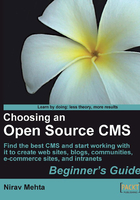
Different types, but strong overlap
We looked at the different types of CMSs, from general-purpose to photo galleries. Each had its own core feature set, but all the CMSs have a strong overlap of functionality. They all essentially allow you to add and manage some type of content—text, images, and files. The way content displays to the end user may be different, but a lot of internals are the same. Here are some of the features you will see in many CMSs:
- WYSIWYG Editor: A What You See Is What You Get editor allows you to enter text and format it. Most such editors even allow you to add images and other media.
- Categories and content hierarchy: Sections, categories or nested levels to organize content are very common.
- Search Engine Optimization: Search engine friendly URLs, meta tags are supported.
- Tagging: Tag content with keywords, then display a "tag cloud" or list.
- Different User Levels: Most CMSs allow multiple users to manage content. Many even have roles and access levels to control what each user can do.
- Plug-in Support: Extend core features by adding plug-ins and extensions.
- Themes/Skins: Customize the look and feel with themes.
- Comments, and so on: Comments and other social media, or Web 2.0 features, are widely available.
As we evaluate each type of CMS later in the book, you will experience the striking similarity in the way content is managed. This is good news actually—you can easily apply lessons you have learned from one CMS to another.
One more striking similarity you may notice is that most open source CMSs are written in PHP. Let's quickly review CMS technologies to understand this phenomenon.